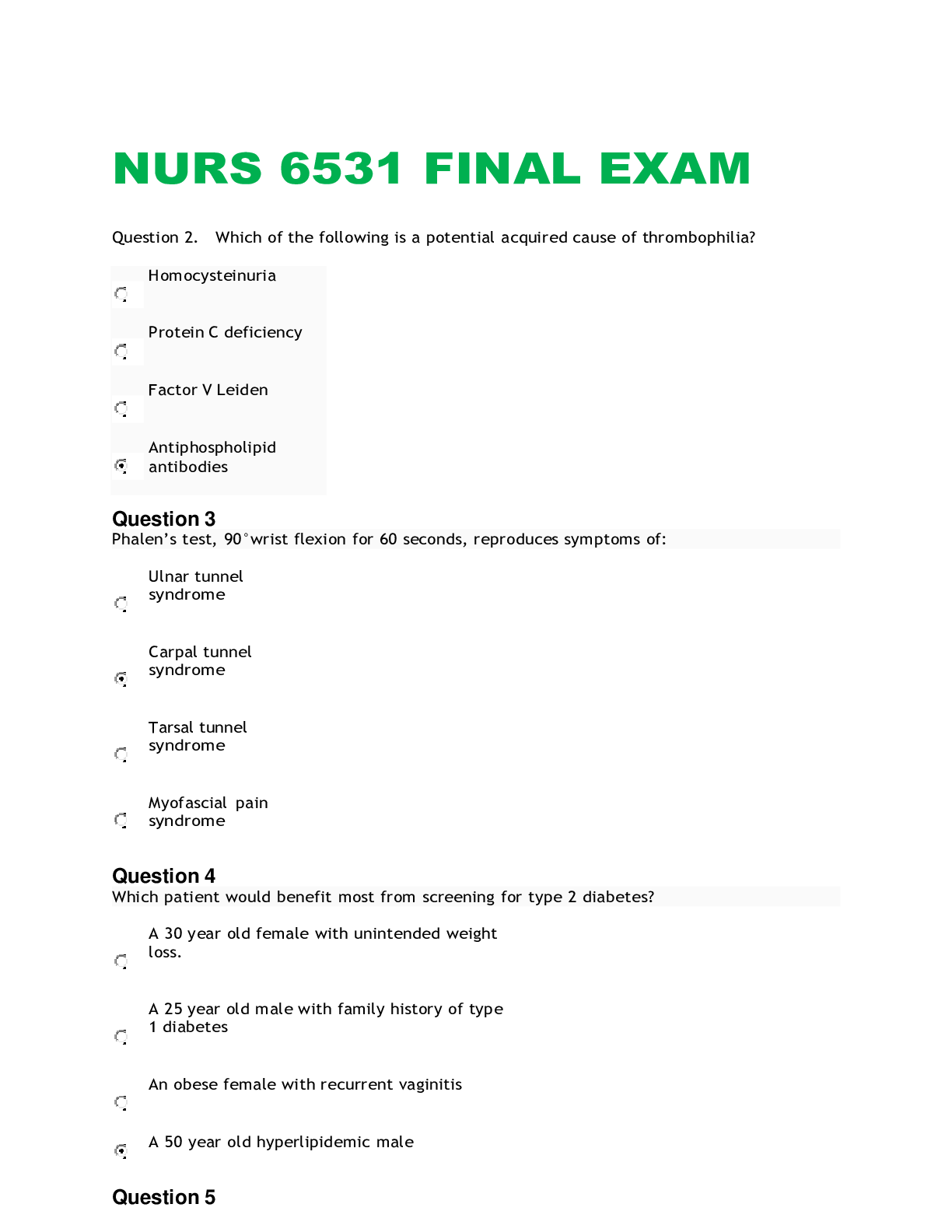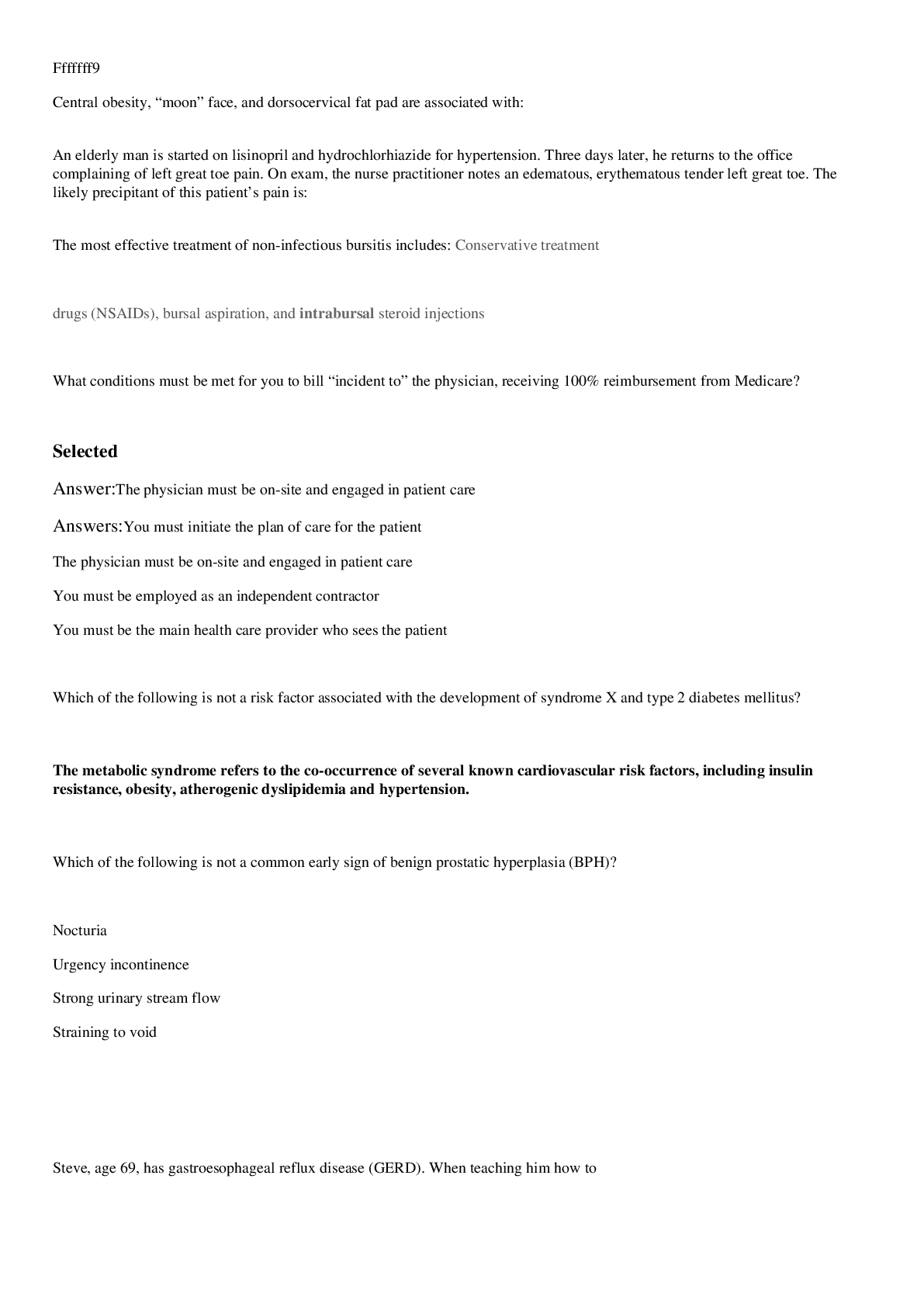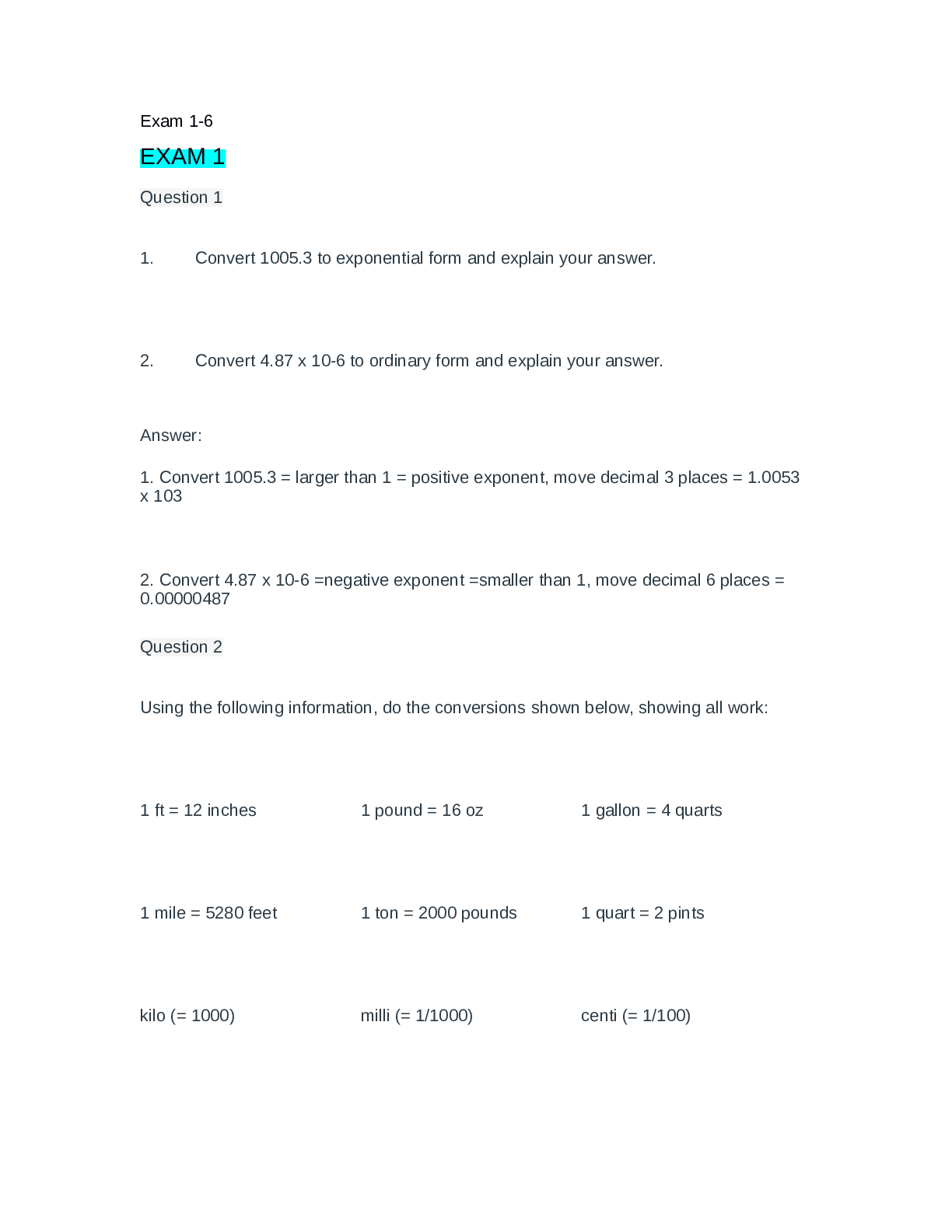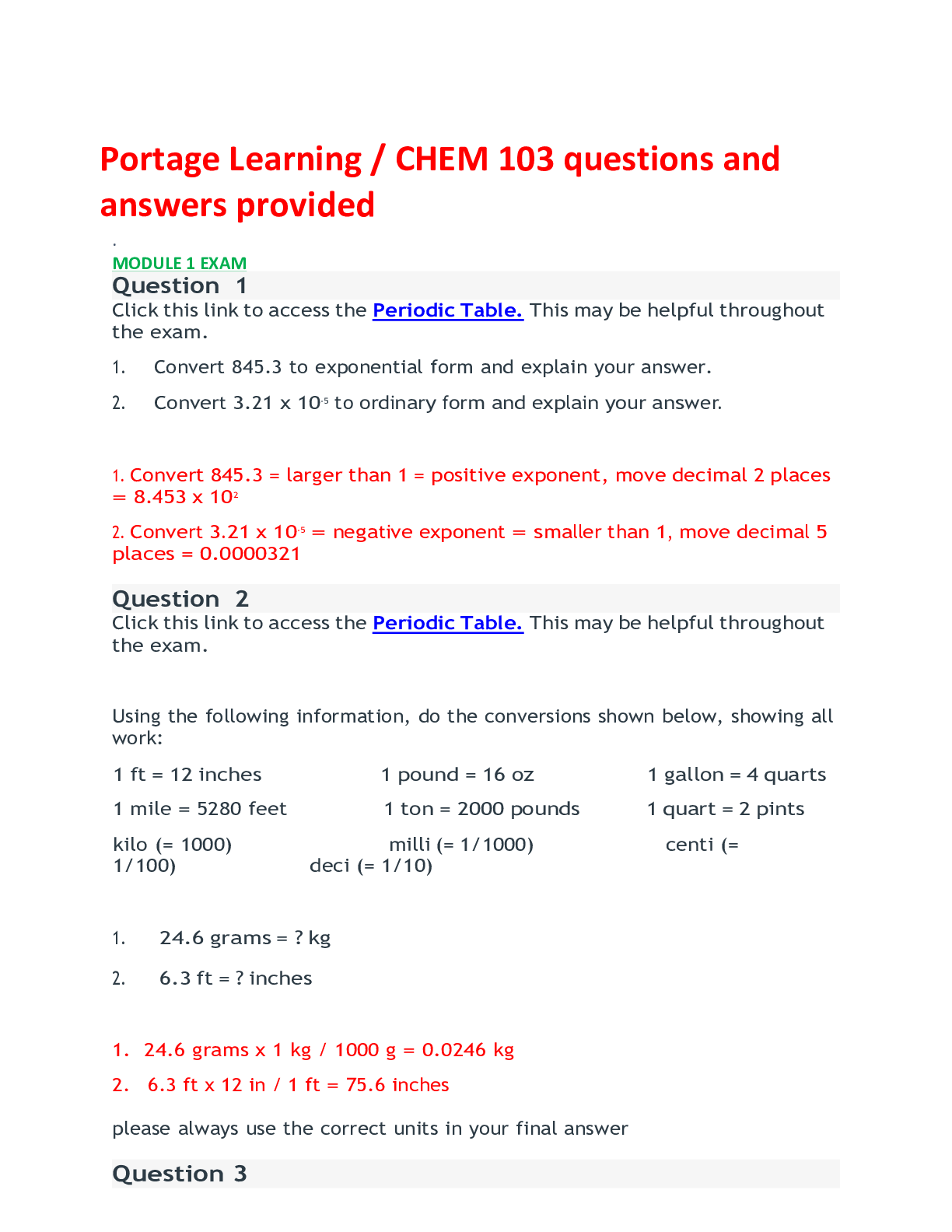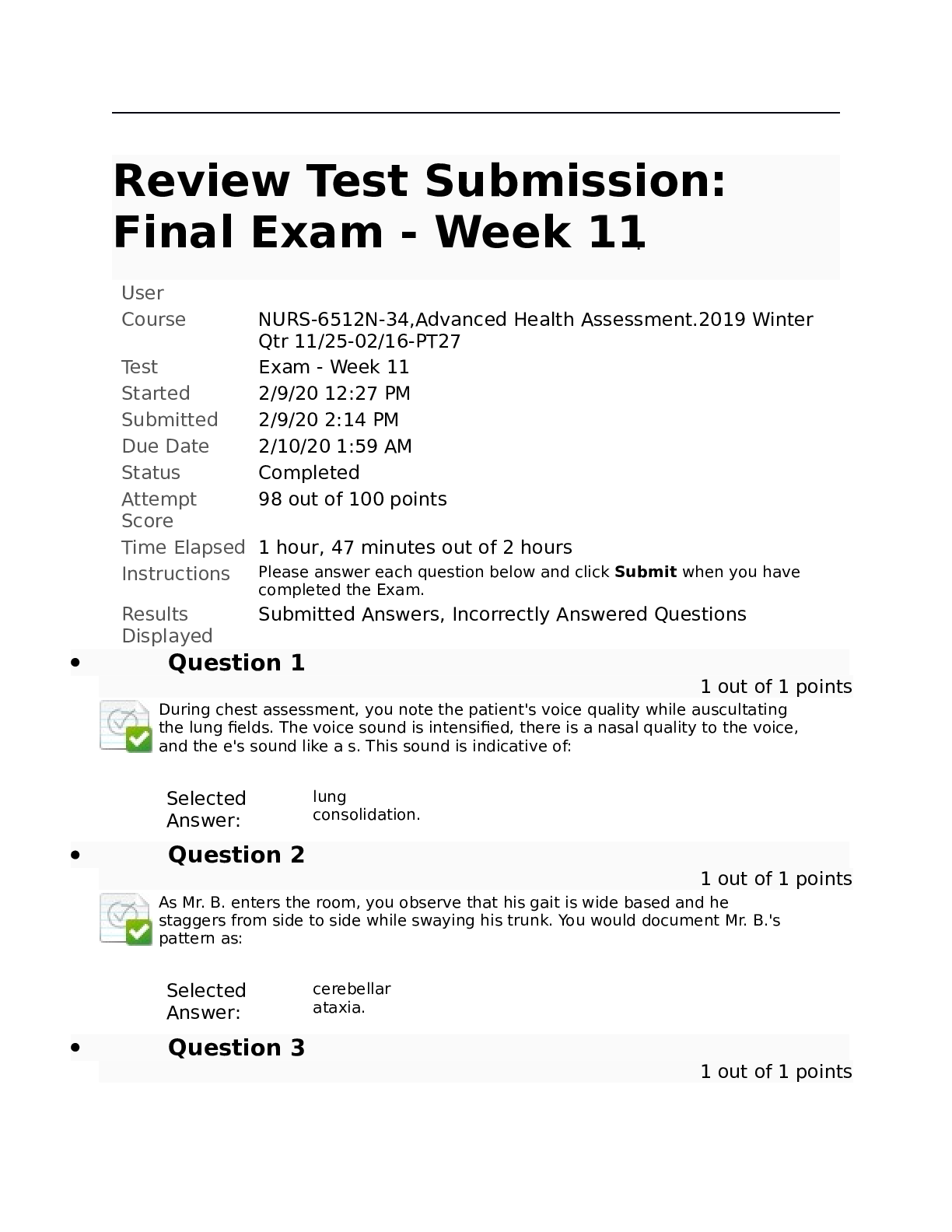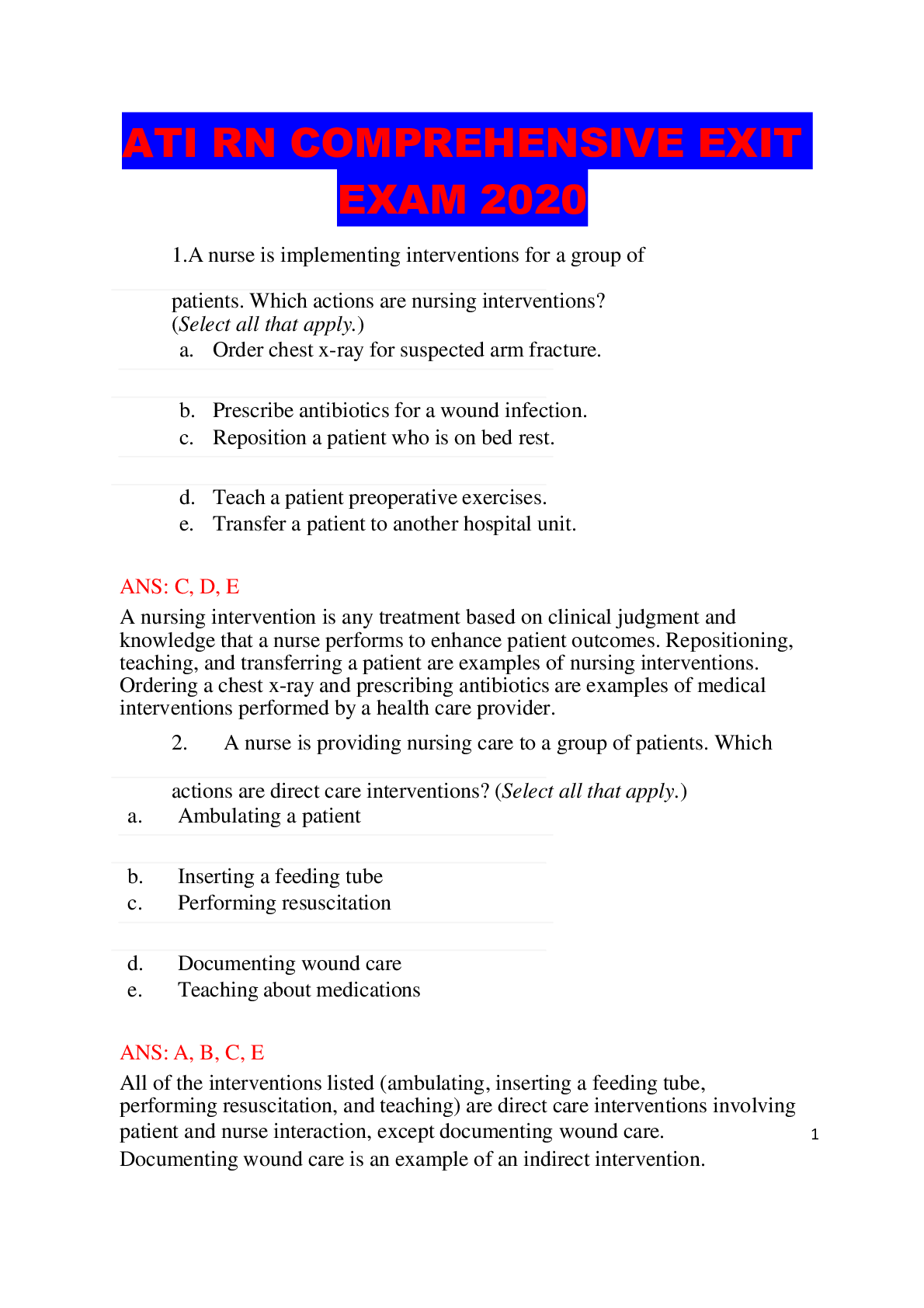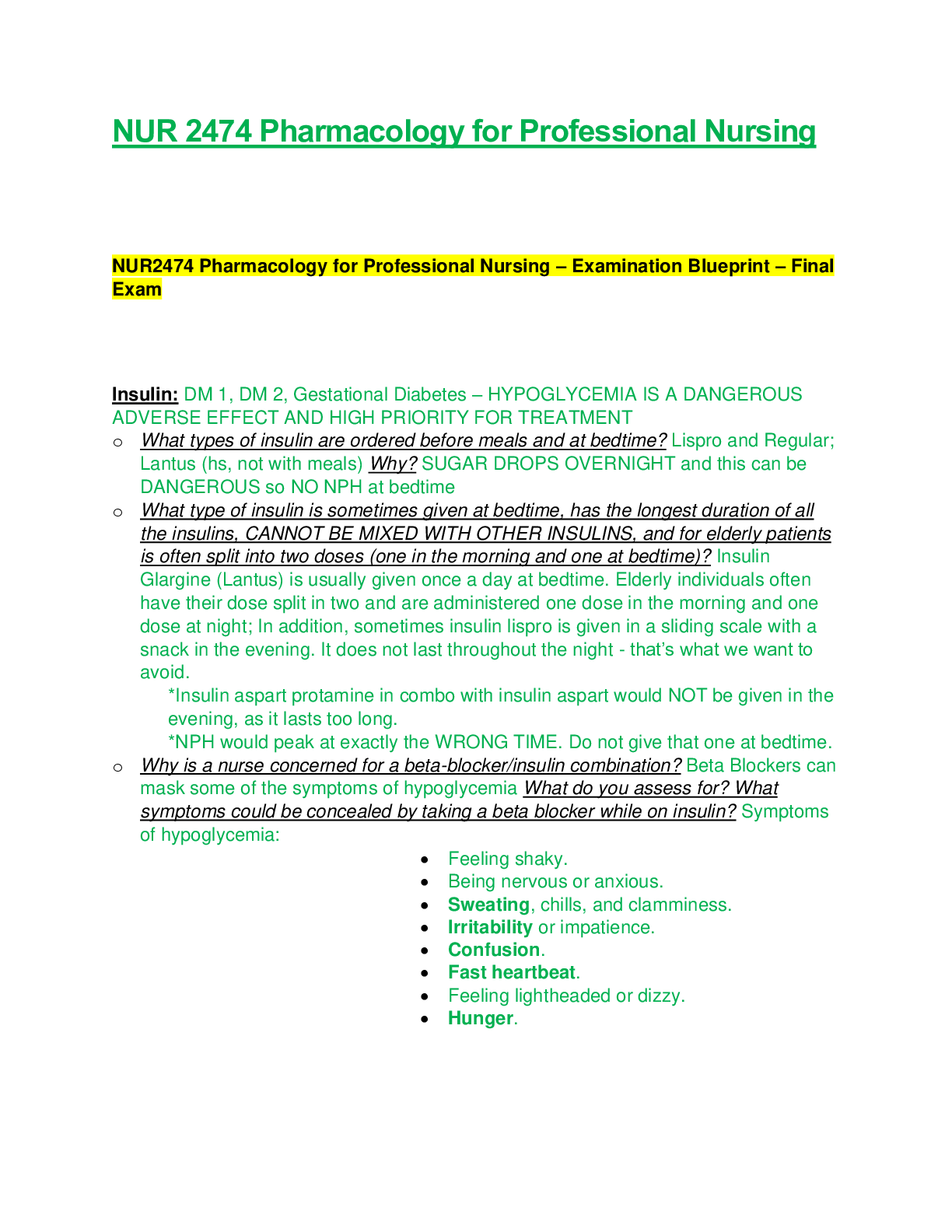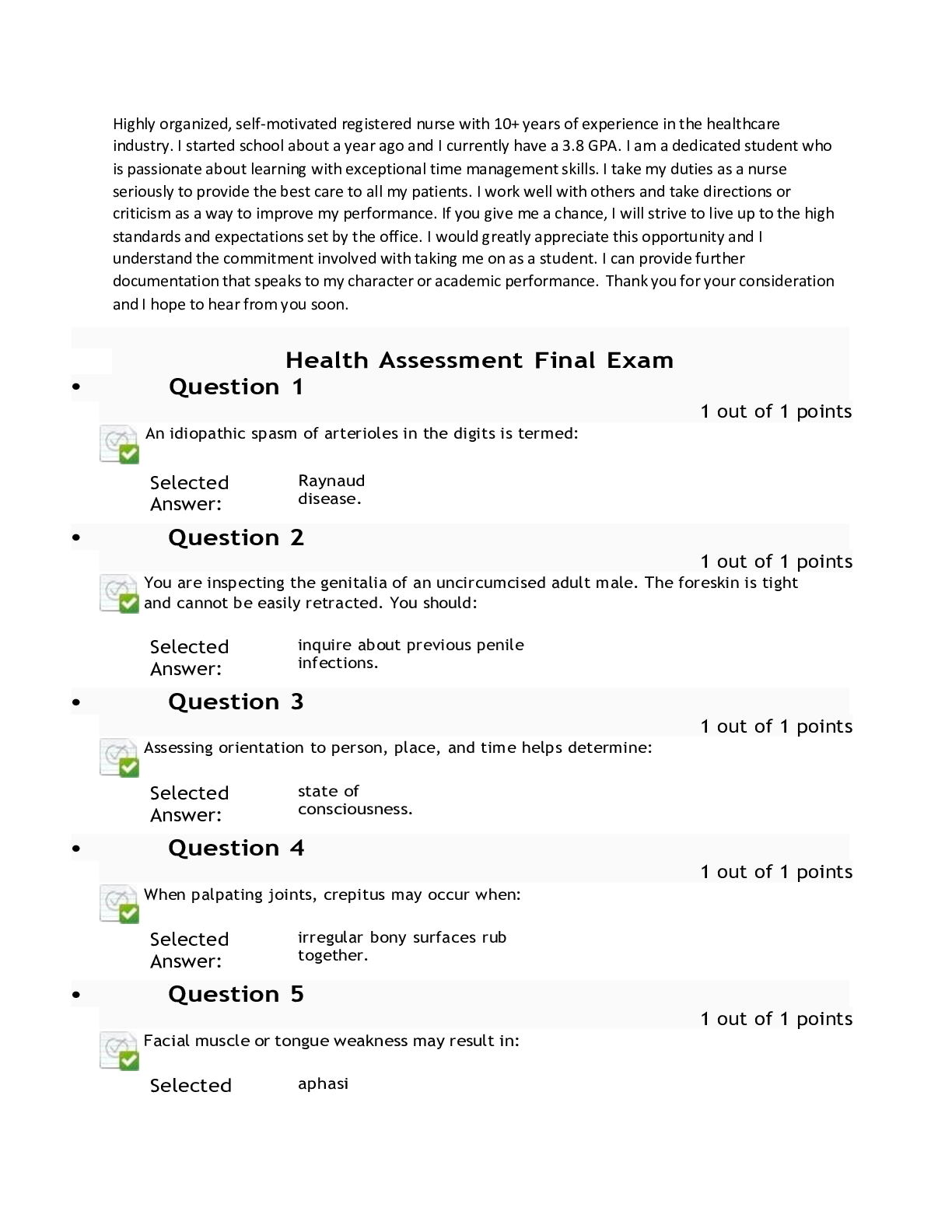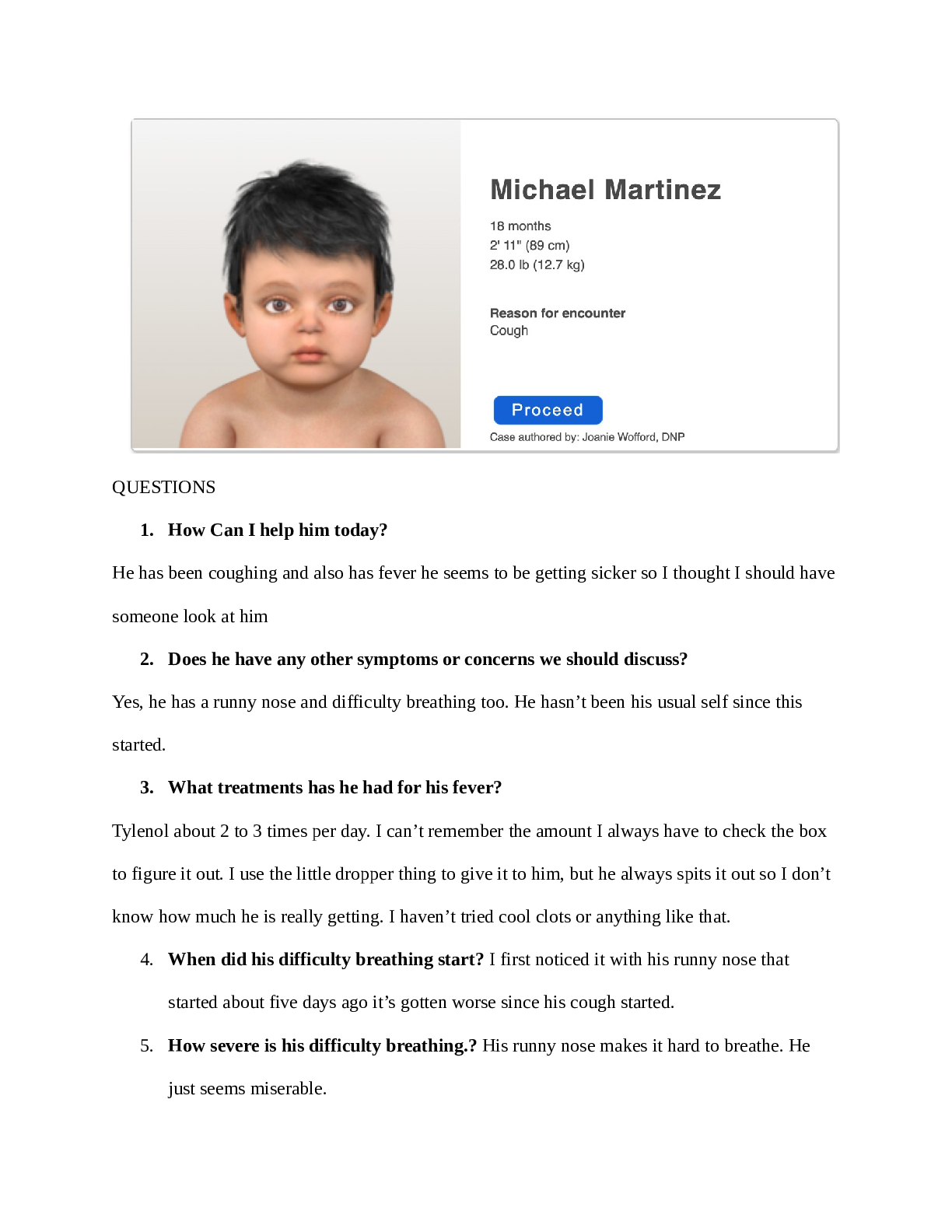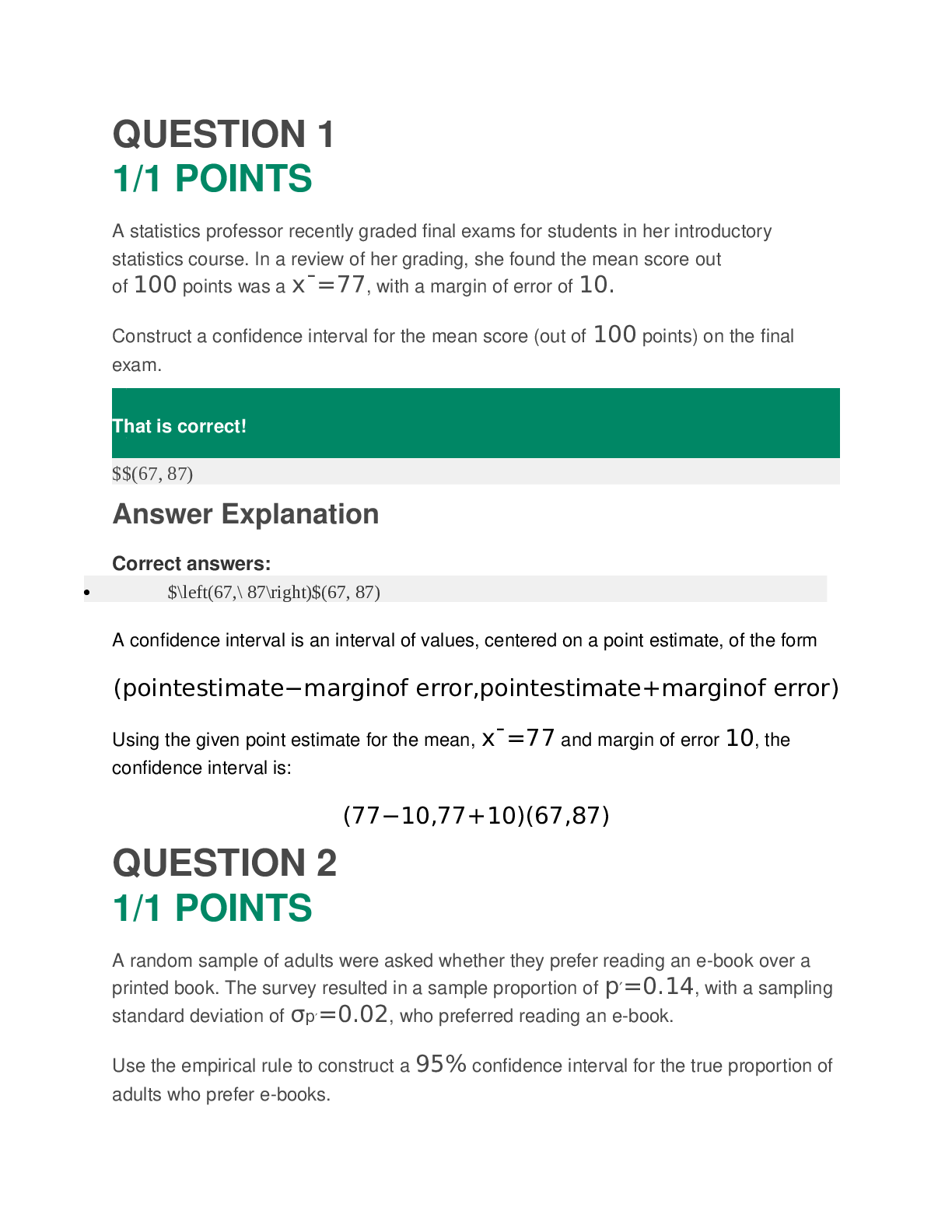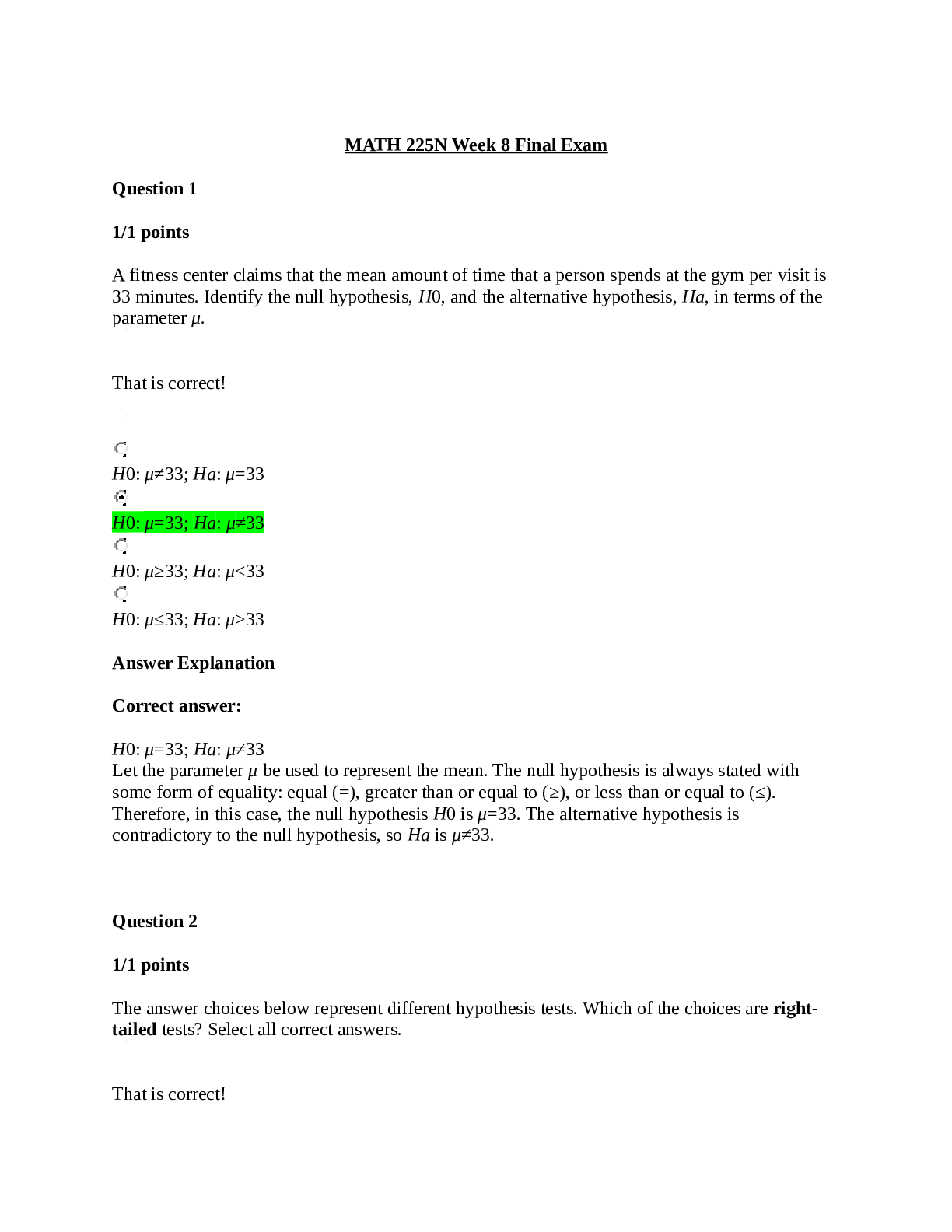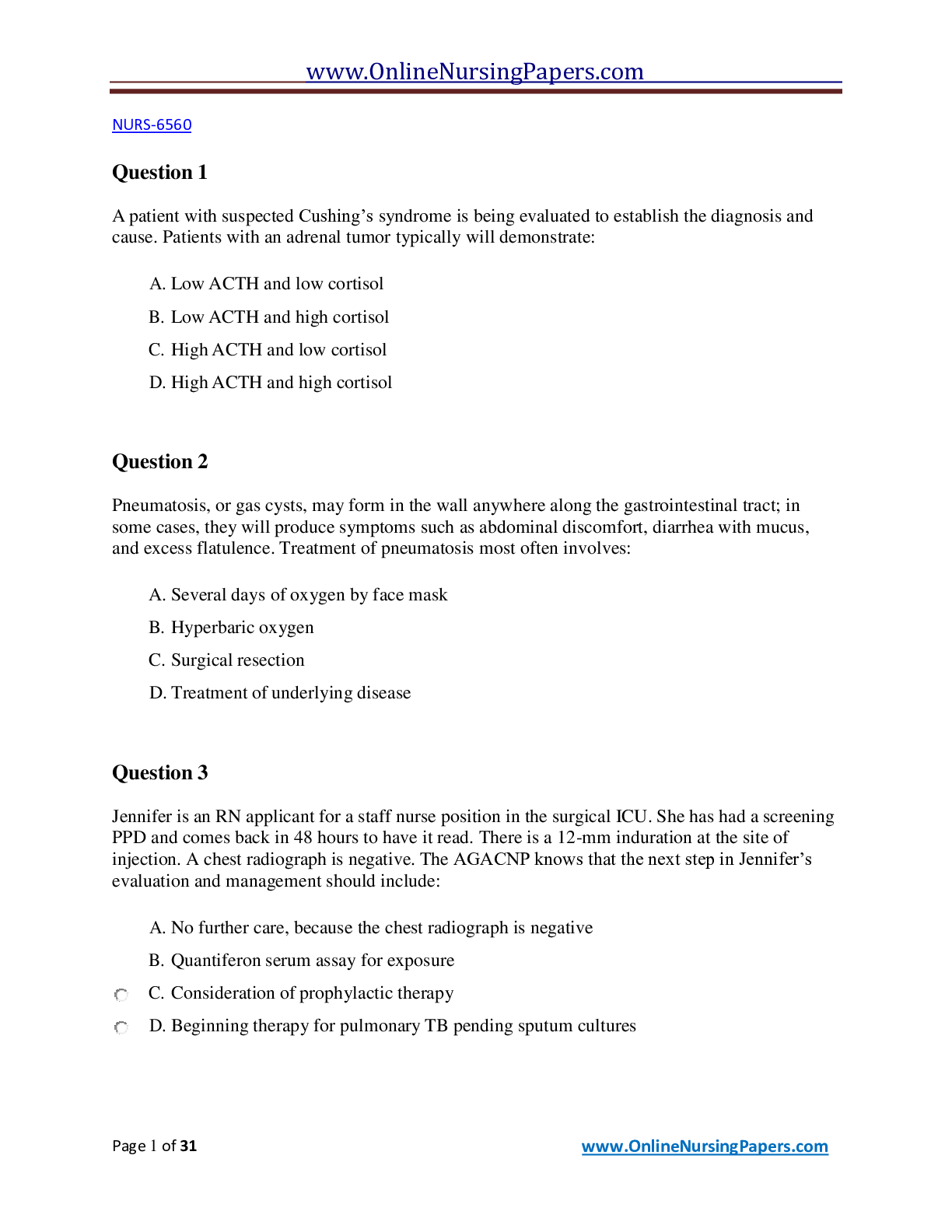*NURSING > Final Exam Review > HIT 205 Final exam B questions with correct answers (All)
HIT 205 Final exam B questions with correct answers
Document Content and Description Below
HIT 205 Final exam B HIT 205 Final exam B Score for this quiz: 30 out of 250 * Submitted Jun 20 at 12:45pm This attempt took 115 minutes. IncorrectQuestion 1 0 / 5 pts (TCO 2) In determini... ng the principal diagnosis, which rule takes precedence over all guidelines? See Chapter 1. Question 2 5 / 5 pts (TCO 2) Which of the following is a true statement? Question 3 5 / 5 pts (TCO 2) Which of the following types of institutions is required to report POA for Medicare? See Chapter 3. Question 4 5 / 5 pts (TCO 2) Which instruction following a main term in the Alphabetic Index indicates that there is another main term that may also be referenced to provide additional Alphabetic Index entries that may be useful? See Chapter 1. Question 5 5 / 5 pts (TCO 2) Which is the correct POA indicator when the documentation is unclear as to whether the condition was present on admission and when the provider is queried and his or her response is, “I don’t know”? See the ICD-10-CM Official Guidelines for Coding and Reporting, Appendix I. IncorrectQuestion 6 0 / 5 pts (TCOs 2, 4, 5, and 6) Which are the correct codes and sequencing for dementia with Parkinsonism? See ICD-10-CM (ICD-10-CM and ICD-10-PCS Coding Handbook 2013 with Answers, American Hospital Association). Question 7 5 / 5 pts (TCOs 2, 4, 5, and 6) Which is the correct code(s) for pneumonia due to RSV? Question 8 5 / 5 pts (TCOs 2, 4, 5, and 6) Which is the correct diagnosis code(s) for bilateral congenital dislocation of hip? Question 9 Not yet graded / 10 pts (TCOs 3, 4, 5, and 6) Using your coding manual (not the encoder or internet) assign the correct ICD-10-CM code(s) for the following condition: coma due to barbiturate overdose, attempted suicide, initial encounter. Question 10 Not yet graded / 10 pts (TCOs 3, 4, 5, and 6) Using your coding manual (not the encoder or internet) assign the correct ICD-10-CM code(s) for the following condition: burning and tingling sensation of toes. Question 11 Not yet graded / 10 pts (TCOs 3, 4, 5, and 6) Using your coding manual (not the encoder or internet) assign the correct ICD-10-CM code(s) for the following condition: orchitis due to Streptococcus. Your Answer: Question 12 Not yet graded / 10 pts (TCOs 3, 4, 5, and 6) Using your coding manual (not the encoder or internet) assign the correct ICD-10-CM code(s) for the following condition: premature baby, 990 gm. birth weight, 29 5/7 weeks of gestation, born in Hospital #1 and transferred to Hospital #2 (Code for hospital #2). Your Answer: Question 13 Not yet graded / 10 pts (TCOs 3, 4, 5, and 6) Using your coding manual (not the encoder or internet) assign the correct ICD-10-CM code(s) for the following condition: insect bites on lower extremities, initial encounter. Your Answer: Question 14 Not yet graded / 10 pts (TCOs 3, 4, 5, and 6) Using your coding manual (not the encoder or internet) assign the correct ICD-10-CM code(s) for the following condition: 5-day-old infant, light-for-dates, 2,200 g birth weight, 35 6/7 week gestational age at birth. Your Answer: Question 15 Not yet graded / 10 pts (TCOs 3, 4, 5, and 6) Using your coding manual (not the encoder or internet) assign the correct ICD-10-CM code(s) for the following condition: secondary thrombocytopenia due to hypersplenism. Your Answer: Question 16 Not yet graded / 10 pts (TCOs 3, 4, 5, and 6) Using your coding manual (not the encoder or internet) assign the correct ICD-10-CM code(s) for the following condition: Metastatic carcinoma of the liver, carcinoma of descending colon. Your Answer: Question 17 Not yet graded / 10 pts (TCOs 3, 4, 5, and 6) Using your coding manual (not the encoder or internet) assign the correct ICD-10-CM code(s) for the following condition: premature baby, 2,000 g birth weight, 35 4/7 weeks of gestation, born in Hospital #1 and transferred to Hospital #2 (code for Hospital #2). Your Answer: Question 18 Not yet graded / 10 pts (TCOs 3, 4, 5, and 6) Using your coding manual (not the encoder or internet) assign the correct ICD-10-CM code(s) for the following condition: polyarthropathy due to dermatological condition, erythema nodosum, multiple sites . Your Answer: Question 19 Not yet graded / 10 pts (TCOs 3, 4, 5, and 6) Using your coding manual (not the encoder or internet) assign the correct ICD-10-CM code(s) for the following condition: acute pyelonephritis due to E. coli. Your Answer: Question 20 Not yet graded / 10 pts (TCOs 3, 4, 5, and 6) Using your coding manual (not the encoder or internet) assign the correct ICD-10-CM code(s) for the following condition: generalized convulsions due to accidental Darvon overdose, initial encounter. Your Answer: Question 21 Not yet graded / 10 pts (TCOs 3, 4, 5, and 6) Using your coding manual (not the encoder or internet) assign the correct ICD-10-CM code(s) for the following condition: urinary tract infection due to the presence of an indwelling urinary catheter, initial encounter. Your Answer: Question 22 Not yet graded / 20 pts Code the following inpatient scenario by assigning ICD-10-CM codes only, do not assign ICD-10-PCS codes: The patient, a six-day-old female, was admitted with respiratory distress, wheezes, and a heart murmur. She was intubated on admission and improved on the ventilator. She was extubated 48 hours later. Respiratory syncytial viral bronchiolitis was diagnosed. Other treatment included antibiotics and aerosols. An echocardiogram indicated a ventricular septal defect. She was to return at a later date for further evaluation. Discharge diagnoses: (1) Respiratory syncytial viral bronchiolitis, (2) ventricular septal defect, (3) respiratory distress. Your Answer: Question 23 Not yet graded / 20 pts Code the following inpatient scenario by assigning ICD-10-CM codes only, do not assign ICD-10-PCS codes: The patient, a female resident of a nursing home, was transferred because of nausea and vomiting. She also had type 1 diabetes mellitus and arteriosclerotic cardiovascular disease. An upper GI X-ray showed esophageal obstruction. She was then admitted with provisional diagnoses of esophageal obstruction versus hiatal hernia versus esophagitis. A gastroscopy was performed to evaluate the stomach, and a partial obstruction due to stricture to the level of the distal esophagus was viewed and dilated. The patient improved without further symptoms. Her blood sugar levels rose to 500 on the third day of admission, and the diabetes was diagnosed as out of control. Her insulin was increased twice in an attempt to lower her blood sugar to baseline. The long-term outlook was not good because the patient was not a candidate for definitive surgery. The esophageal stricture was thought to have resulted from a previous cerebrovascular accident. Discharge diagnoses: (1) Esophageal stricture; (2) arteriosclerotic cardiovascular disease; (3) uncontrolled diabetes mellitus, type 1. Your Answer: Question 24 Not yet graded / 20 pts Code the following inpatient scenario by assigning ICD-10-CM codes only, do not assign CPT codes: The patient was seen to evaluate his progress in dealing with his long-standing alcoholism. In addition, he had a passive-aggressive personality and was dependent on Librium. He was actively participating in Alcoholics Anonymous and stated he would continue to participate. He apparently now had some alcoholic liver damage and was referred to an internist for further investigation of that condition. Diagnoses: (1) Alcohol dependence; (2) passive-aggressive personality disorder; (3) drug dependence, Librium; (4) alcoholic liver damage. Your Answer: Question 25 Not yet graded / 20 pts Code the following inpatient scenario by assigning ICD-10-CM codes only, do not assign ICD-10-PCS codes: The patient, an 18-month-old boy, was admitted with right orbital cellulitis. He was started on antibiotics and seemed to be improving. However, the day after admission a slight exophthalmos was noticed. A non-contrast CT scan of the head showed increasing edema of the eye orbit with filling of ethmoid sinuses. The medications were changed. A right endoscopic complete ethmoidectomy was performed because the ethmoid sinuses were filled on the right side. The infant improved and was discharged in satisfactory condition. Discharge diagnoses: (1) Right orbital abscess; (2) exophthalmos, right orbital edema; (3) acute ethmoidal sinusitis (4) Hypertension. Your Answer: Previous Submission Details: [Show More]
Last updated: 1 year ago
Preview 1 out of 10 pages
Instant download
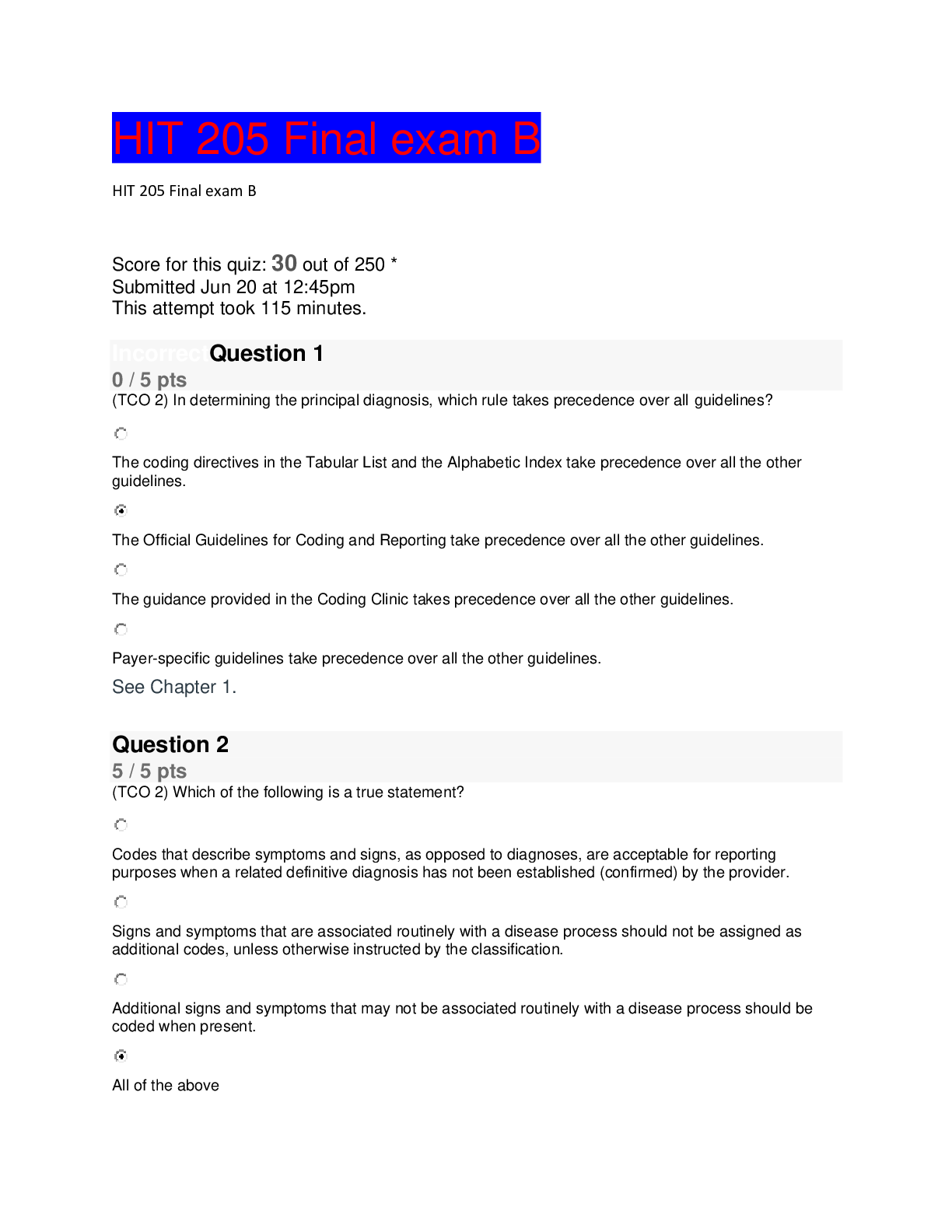
Buy this document to get the full access instantly
Instant Download Access after purchase
Add to cartInstant download
Reviews( 0 )
Document information
Connected school, study & course
About the document
Uploaded On
Feb 07, 2021
Number of pages
10
Written in
Additional information
This document has been written for:
Uploaded
Feb 07, 2021
Downloads
0
Views
47

